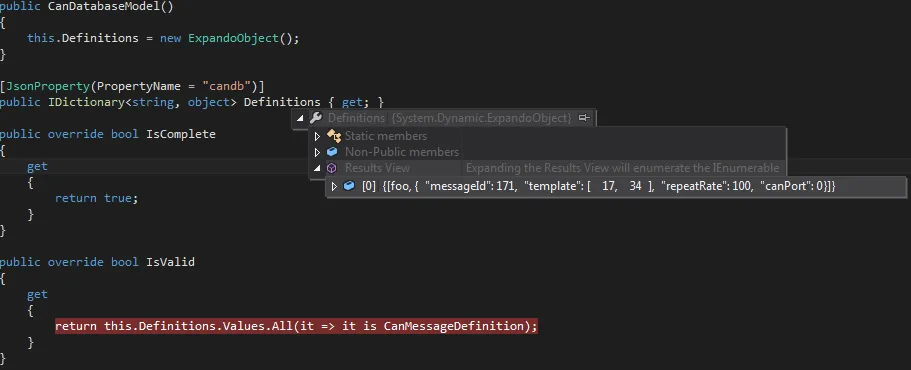由于似乎没有官方的方法来做到这一点,我想出了一个临时解决方案™(即:一个足够好用的解决方案,所以我可能会一直使用它)。
为了让JSON Patch处理类似字典的操作,我创建了一个名为DynamicDeserialisationStore的类,该类继承自DynamicObject并利用JSON Patch对动态对象的支持。
更具体地说,该类重写了TrySetMember、TrySetIndex、TryGetMember等方法,以基本上像字典一样运作,只是将所有这些操作委托给其构造函数提供的回调函数。
实现
以下代码提供了DynamicDeserialisationStore的实现。它实现了IDictionary<string,object>(这是JSON Patch要求与动态对象一起工作的签名),但我仅实现了我需要的最少量的方法。
JSON Patch对动态对象的支持问题在于它将属性设置为
JObject实例,即当设置静态属性时它不会自动执行反序列化,因为它无法推断类型。
DynamicDeserialisationStore是根据它将尝试自动反序列化这些
JObject实例的对象类型进行参数化的。
该类接受回调来处理基本字典操作,而不是维护内部字典本身,因为在我的“真实”系统模型代码中,我实际上不使用字典(由于各种原因),我只是让它看起来像客户端使用字典一样。
internal sealed class DynamicDeserialisationStore<T> : DynamicObject, IDictionary<string, object> where T : class
{
private readonly Action<string, T> storeValue;
private readonly Func<string, bool> removeValue;
private readonly Func<string, T> retrieveValue;
private readonly Func<IEnumerable<string>> retrieveKeys;
public DynamicDeserialisationStore(
Action<string, T> storeValue,
Func<string, bool> removeValue,
Func<string, T> retrieveValue,
Func<IEnumerable<string>> retrieveKeys)
{
this.storeValue = storeValue;
this.removeValue = removeValue;
this.retrieveValue = retrieveValue;
this.retrieveKeys = retrieveKeys;
}
public int Count
{
get
{
return this.retrieveKeys().Count();
}
}
private IReadOnlyDictionary<string, T> AsDict
{
get
{
return (from key in this.retrieveKeys()
let value = this.retrieveValue(key)
select new { key, value })
.ToDictionary(it => it.key, it => it.value);
}
}
public override bool TrySetIndex(SetIndexBinder binder, object[] indexes, object value)
{
if (indexes.Length == 1 && indexes[0] is string && value is JObject)
{
return this.TryUpdateValue(indexes[0] as string, value);
}
return base.TrySetIndex(binder, indexes, value);
}
public override bool TryGetIndex(GetIndexBinder binder, object[] indexes, out object result)
{
if (indexes.Length == 1 && indexes[0] is string)
{
try
{
result = this.retrieveValue(indexes[0] as string);
return true;
}
catch (KeyNotFoundException)
{
}
}
return base.TryGetIndex(binder, indexes, out result);
}
public override bool TrySetMember(SetMemberBinder binder, object value)
{
return this.TryUpdateValue(binder.Name, value);
}
public override bool TryGetMember(GetMemberBinder binder, out object result)
{
try
{
result = this.retrieveValue(binder.Name);
return true;
}
catch (KeyNotFoundException)
{
return base.TryGetMember(binder, out result);
}
}
private bool TryUpdateValue(string name, object value)
{
JObject jObject = value as JObject;
T tObject = value as T;
if (jObject != null)
{
this.storeValue(name, jObject.ToObject<T>());
return true;
}
else if (tObject != null)
{
this.storeValue(name, tObject);
return true;
}
return false;
}
object IDictionary<string, object>.this[string key]
{
get
{
return this.retrieveValue(key);
}
set
{
this.TryUpdateValue(key, value);
}
}
public IEnumerator<KeyValuePair<string, object>> GetEnumerator()
{
return this.AsDict.ToDictionary(it => it.Key, it => it.Value as object).GetEnumerator();
}
public void Add(string key, object value)
{
this.TryUpdateValue(key, value);
}
public bool Remove(string key)
{
return this.removeValue(key);
}
#region Unused methods
bool ICollection<KeyValuePair<string, object>>.IsReadOnly
{
get
{
throw new NotImplementedException();
}
}
ICollection<string> IDictionary<string, object>.Keys
{
get
{
throw new NotImplementedException();
}
}
ICollection<object> IDictionary<string, object>.Values
{
get
{
throw new NotImplementedException();
}
}
void ICollection<KeyValuePair<string, object>>.Add(KeyValuePair<string, object> item)
{
throw new NotImplementedException();
}
void ICollection<KeyValuePair<string, object>>.Clear()
{
throw new NotImplementedException();
}
bool ICollection<KeyValuePair<string, object>>.Contains(KeyValuePair<string, object> item)
{
throw new NotImplementedException();
}
bool IDictionary<string, object>.ContainsKey(string key)
{
throw new NotImplementedException();
}
void ICollection<KeyValuePair<string, object>>.CopyTo(KeyValuePair<string, object>[] array, int arrayIndex)
{
throw new NotImplementedException();
}
IEnumerator IEnumerable.GetEnumerator()
{
throw new NotImplementedException();
}
bool ICollection<KeyValuePair<string, object>>.Remove(KeyValuePair<string, object> item)
{
throw new NotImplementedException();
}
bool IDictionary<string, object>.TryGetValue(string key, out object value)
{
throw new NotImplementedException();
}
#endregion
}
测试
下面提供了该类的测试。我创建了一个模拟系统模型(见图像),并对其执行了各种JSON Patch操作。

这里是代码:
public class DynamicDeserialisationStoreTests
{
private readonly FooSystemModel fooSystem;
public DynamicDeserialisationStoreTests()
{
this.fooSystem = new FooSystemModel();
}
[Fact]
public void Store_Should_Handle_Adding_Keyed_Model()
{
this.fooSystem.Foos.ShouldBeEmpty();
var request = "{\"op\":\"add\",\"path\":\"/foos/test\",\"value\":{\"number\":3,\"bazzed\":true}}";
var operation = JsonConvert.DeserializeObject<Operation<FooSystemModel>>(request);
var patchDocument = new JsonPatchDocument<FooSystemModel>(
new[] { operation }.ToList(),
new CamelCasePropertyNamesContractResolver());
patchDocument.ApplyTo(this.fooSystem);
this.fooSystem.Foos.ShouldHaveSingleItem();
FooModel foo = this.fooSystem.Foos["test"] as FooModel;
foo.Number.ShouldBe(3);
foo.IsBazzed.ShouldBeTrue();
}
[Fact]
public void Store_Should_Handle_Removing_Keyed_Model()
{
var testFoo = new FooModel { Number = 3, IsBazzed = true };
this.fooSystem.Foos["test"] = testFoo;
var request = "{\"op\":\"remove\",\"path\":\"/foos/test\"}";
var operation = JsonConvert.DeserializeObject<Operation<FooSystemModel>>(request);
var patchDocument = new JsonPatchDocument<FooSystemModel>(
new[] { operation }.ToList(),
new CamelCasePropertyNamesContractResolver());
patchDocument.ApplyTo(this.fooSystem);
this.fooSystem.Foos.ShouldBeEmpty();
}
[Fact]
public void Store_Should_Handle_Modifying_Keyed_Model()
{
var originalFoo = new FooModel { Number = 3, IsBazzed = true };
this.fooSystem.Foos["test"] = originalFoo;
var request = "{\"op\":\"replace\",\"path\":\"/foos/test\", \"value\":{\"number\":6,\"bazzed\":false}}";
var operation = JsonConvert.DeserializeObject<Operation<FooSystemModel>>(request);
var patchDocument = new JsonPatchDocument<FooSystemModel>(
new[] { operation }.ToList(),
new CamelCasePropertyNamesContractResolver());
patchDocument.ApplyTo(this.fooSystem);
this.fooSystem.Foos.ShouldHaveSingleItem();
FooModel foo = this.fooSystem.Foos["test"] as FooModel;
foo.Number.ShouldBe(6);
foo.IsBazzed.ShouldBeFalse();
}
#region Mock Models
private class FooModel
{
[JsonProperty(PropertyName = "number")]
public int Number { get; set; }
[JsonProperty(PropertyName = "bazzed")]
public bool IsBazzed { get; set; }
}
private class FooSystemModel
{
private readonly IDictionary<string, FooModel> foos;
public FooSystemModel()
{
this.foos = new Dictionary<string, FooModel>();
this.Foos = new DynamicDeserialisationStore<FooModel>(
storeValue: (name, foo) => this.foos[name] = foo,
removeValue: name => this.foos.Remove(name),
retrieveValue: name => this.foos[name],
retrieveKeys: () => this.foos.Keys);
}
[JsonProperty(PropertyName = "foos")]
public IDictionary<string, object> Foos { get; }
}
#endregion
}



value对象中的template吗?我们可以将messageId和template移动到父对象中吗? - Ankittemplate表示 CAN 消息负载(0-8 字节),因此它将是一个整数数组。messageId和template必须保持不变,因为请求需要遵循 RFC 6902 中描述的 JSON Patch 模式。 - TagcPropertyChanged事件处理程序注册到ExpandoObject,手动将新的JObject转换为CanMessageDefinition)。 - TagcIDictionary<T, K>。您是否尝试使用Dictionary<T, K>?我正在使用它,没有遇到任何问题。 - Sinaesthetic